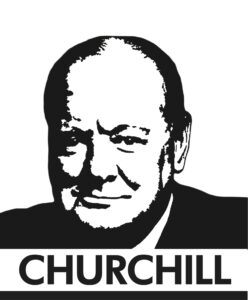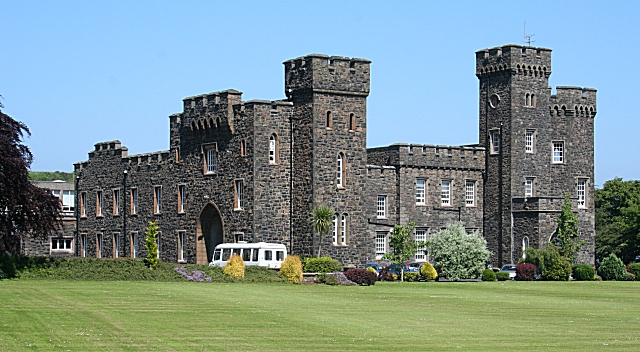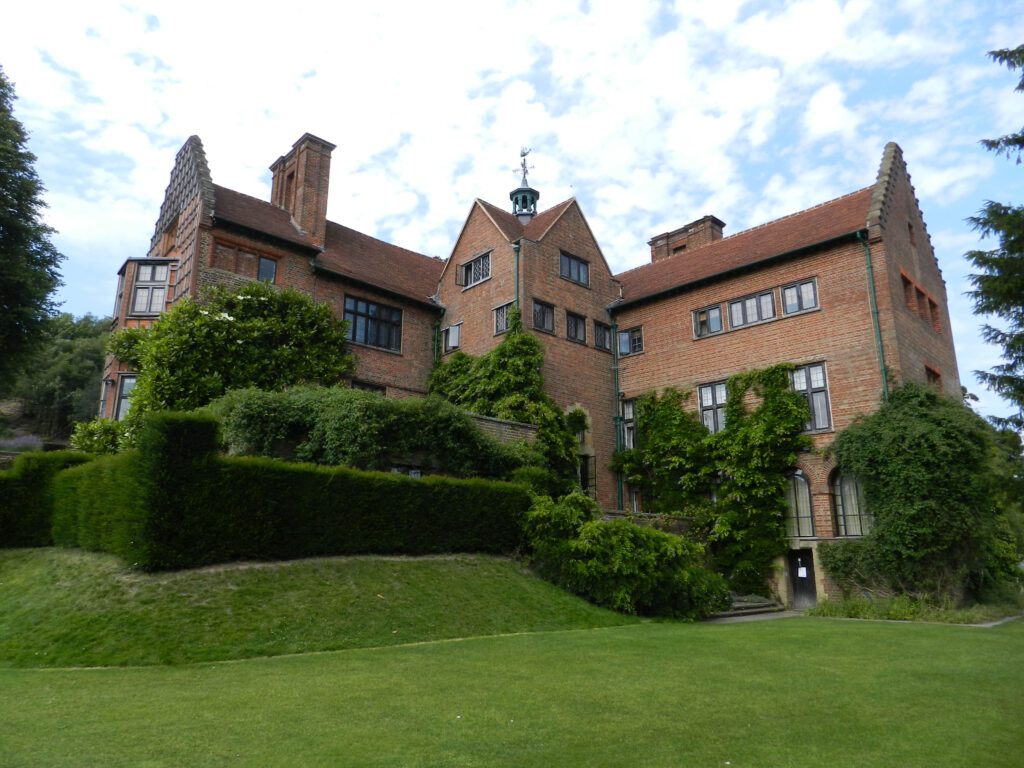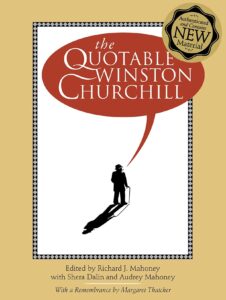
Finest Hour 197
“We Need Never Be Worried about Money Again”

Garron Tower
March 31, 2024
Winston Churchill and the Garron Tower Estate
Finest Hour 197, Third Quarter 2022
Page 30
By David Lough
David Lough is author of No More Champagne: Churchill and His Money (2015), from which this article is developed.
On 26 January 1921 two trains collided in Wales on a length of single track between Welshpool and Newtown. Among the victims was a fifty-one-year old railway director, Lord Herbert Vane-Tempest, the current beneficiary of the Garron Tower estate and first cousin of the late Lord Randolph Churchill. Since Lord Herbert remained unmarried and heirless, his grandmother’s will ordained that the whole estate should jump across to the eldest surviving Churchill male: Winston.
Lord Herbert’s grandmother, and Winston Churchill’s great-grandmother, was Frances Vane, the Marchioness of Londonderry. Her husband, the third Marquess, was an Anglo-Irish aristocrat who had served in the Napoleonic Wars and the suppression of the 1798 Irish Rebellion. From each of her parents, Frances had inherited property in County Antrim. In 1850, at a cost of £4,000, she built a summer residence north of Carnlough, which she named Garron Tower.
To prevent her estate from being broken up, the marchioness’s will established a strict order of precedence to the estate among her heirs. Since her eldest son had already inherited the Londonderry fortune and his eldest son would in turn do likewise, the marchioness left her own estate to her younger grandchildren: first, her eldest son’s second son Lord Herbert Vane-Tempest and his heirs; failing whom, her eldest son’s third son Lord Henry Vane-Tempest and his heirs; failing whom, Lord Randolph Churchill and his heirs, because he was the son of her daughter, another Frances, who had married the seventh Duke of Marlborough.

2024 International Churchill Conference
All very complicated, and the chances of Lord Randolph or his heirs ever succeeding appeared at first remote. Lord Randolph’s early death in 1895 opened up his line of succession to Winston Churchill, but both Lord Herbert’s and Lord Henry’s lines ranked above him; moreover they remained young and vigorous. In 1906, however, Lord Henry died childless. With Lord Herbert still unmarried at the age of fortyfour, Churchill became the heir presumptive.
Now worried by the possibility of the estate passing to the English branch of the family, the Londonderrys determined to buy their grandmother’s jewellery out of the estate, a move that required Churchill’s formal approval as the next in line. Churchill felt that he could hardly resist, so suggested through his solicitor an independent valuation of the jewels (the Londonderry’s adviser had suggested a price of £4,420) and that he should keep an option to buy the jewels back if he succeeded. The Londonderrys unsurprisingly demurred, since it would have defeated the whole object of the exercise.
Inheritance
By the time Lord Herbert perished in the train wreck in 1921, Churchill had been next in line for more than a decade, but had only occasionally concerned himself with the estate’s affairs. In 1909 his solicitors had told him that its income amounted to £3,700 a year; in 1919 they told him that its capital value stood at almost £90,000, the majority safely invested in Irish government bonds and stocks after the trustees had sold most of the estate’s houses and the fire-damaged Garron Tower itself, which had recently operated as a hotel. The estate’s only remaining bricks and mortar consisted of the local Carnlough Lime Works, its harbour, and nearby tenements, whose rents hardly matched the costs of their collection.
Lord Herbert’s lawyer notified Churchill’s solicitor of the inheritance on the day after the accident. He mentioned a likely annual income of £4,200 a year, but could neither estimate the capital value nor the likely estate duty to be paid. These were the sums that mattered to Churchill because the estate’s move to a younger generation meant that it was no longer tied up in trust. Lord Herbert had only enjoyed the income from the estate, but Churchill would have access to its capital and its potential to transform his finances.
Churchill’s first step was to arrange an immediate meeting to soothe the fears of William Bernau, his bank manager at Cox & Co, with whom a crisis had been brewing since his customer’s loans and overdraft had now reached almost £28,000. Clementine Churchill’s priority, on the other hand, was to attack their customary pile of unpaid bills. “What would you really wish done about the Bills?” she asked her husband. “In the first flush of the rosy news, you suggested paying them off & you said I was to send them all to you to have dealt with—it would be heavenly if this could be done, but I don’t know if you really mean it.”
The following day Clementine was still absorbing the news. “I can’t describe the blessed feeling of relief that we need never be worried about money again (except thro’ our own fault of course!),” she told Churchill. “It is like floating in a bath of cream.” In her excitement, Clementine wrote to her husband daily for four days. “We will have to pay our bills more regularly now that we are substantial people, shan’t we?” she mused, before asking for an infusion of funds. “Please may I have a little money now that you are what the French call a ‘rentier’?” As regards her husband’s promised articles on painting for The Strand Magazine, she wondered if he could now afford to drop them, as she felt they were bad for his image. Churchill still wrote the articles.
Clementine’s only regret was that the jewels were no longer part of the Garron Tower estate. Sensing her disappointment, Churchill considered a renewed effort to recover them before telling the seventh Marquess of Londonderry, who also happened to be his under-secretary at the Air Ministry, that he would honour their earlier arrangement. “I am sorry you regret the jewels but I am not sure you need to do that,” his cousin responded, dispatching his butler to the Churchill’s residence in Sussex Square with what could be found of his great-grandmother’s silver. “The emeralds are nice,” he wrote to his cousin and political superior, “but now no one likes anything but the Cartier setting.”
A “Crumpled Rose Leaf”
Churchill moved to the Colonial Office in February and was due to leave soon for Cairo to chair an imperial conference on the Middle East [see FH 196]. He and his bank manager hoped that most of the estate’s investments could be transferred to Cox & Co, while he was away. Churchill agreed to repay the small portion of his loans that his cousin the Duke of Marlborough had guaranteed almost twenty-five years earlier, but preferred to keep the rest until the final size of his inheritance was known.
“I had a blow yesterday when I found that the Estate is about £7,000 less than I thought,” Churchill told Clementine soon afterwards. “It now seems likely to work out at about £57,000 after duty. This would have been £85,000 pre-war.”
Clementine was philosophical:
I am sorry my Dearest that you have had a deception as to the amount of the inheritance. It is certainly very disappointing after you had worked it out so carefully & thought about how to lay it out to the best advantage; but don’t let a ‘crumpled rose leaf’ like this spoil the really glorious fact which rushed on us so suddenly a little time ago—that humiliating care had vanished for ever from our lives….It’s so delicious to be easy—I hope I shall never take it for granted but always feel like a cork bobbing on a sunny sea.
Could he not, she asked, “take me in your waistcoat pocket to Egypt?” Churchill agreed she could come, prompting a followup question from Clementine as to whether Bessie, her lady’s maid, could travel too? Bessie made the journey.

A Second Inheritance
The Churchills journeyed in style for six weeks—breaching ministerial travel guidelines by booking a luxury cabin for the sea journey—before returning in the spring of 1921 to find that the transfer of the Garron Tower estate had made little progress during their absence. Its final value had turned out to be £64,000, reduced by estate duty to £56,000.
Nevertheless Churchill decided his windfall should be used to enlarge his investment portfolio, rather than reduce his borrowings. Proudly handing over to his bank manager a two-page list of the investments he had inherited, Churchill invited Bernau to select his security for the new consolidated loan of £30,000 that would replace his old borrowings. In the same expansive vein he increased Clementine’s monthly housekeeping allowance by a third. The Churchills’ spending had moved up another gear.
Five months after his Garron Towers inheritance, Churchill’s mother Jennie died of a sudden hemorrhage on 29 June 1921. Her personal debts exceeded her assets, but Churchill and his brother Jack each came into a half share of their parents’ trusts. These produced another £54,000 of capital for Churchill, although their disadvantage compared to the Irish inheritance was that the capital remained tied up in trust to protect the next generation. He could only touch the capital if the transaction was treated as a loan and he paid the trustees a market rate of interest.
Spending Spree
Despite these restrictions, Churchill and Clementine decided during the summer of 1921 to acquire some of the trappings associated with their new station in life: a country house, a trust for their children, and a smart car.
The car was a Rolls Royce Silver Ghost Cabriolet, costing £2,593, which Churchill christened during a September motoring holiday around Scotland. As he drove the Rolls to a cabinet meeting in Inverness, however, he collided near Cromarty Firth with a car carrying a disabled man. Conscious of his handsome Irish inheritance, Churchill sent the man a cheque for £500 plus £30 for repairs, but the incident was to signal the end of the Rolls-Royce’s short life with the Churchill family.
Winston and Clementine next decided to transfer £10,000 of their inheritance to a trust for their children. The move was not entirely altruistic: as trustees, they could still control how the money was spent and the trust’s own set of allowances would help to reduce the family’s overall burden of taxation, now that higher rates for the better-off were set to remain a permanent feature of the post-war landscape. Churchill planned to borrow the full amount straight back from the trust and to deduct the cost of interest from his own taxable income, thus reducing his own tax rate—a double tax benefit.
Churchill knew it was a politically sensitive move, so he held off signing the legal papers for a while. A recent royal commission had recommended closing down the tax abuses of the trust system, but he went ahead early in 1922 when well-organized lobbying resulted in many of the loopholes remaining open.

The most significant result of his Irish inheritance was that Churchill felt he could now resurrect his dream of owning a country house. That summer he inspected Chartwell, a west Kent manor large enough to house a family of nine children, a domestic staff of thirteen, and an outdoor team of twenty to look after its seventy acres of land. Clementine, fearing the expense of “farming,” preferred the idea of the house on its own. She did agree to inspect Chartwell, however, and initially changed her mind about it: “My darling, I can think of nothing but that heavenly tree-crowned Hill. It is rather like a view from an aeroplane up there.”
That autumn Chartwell failed to sell at auction, but in the summer of 1922 the seller’s agents offered Churchill ten days in which to buy it at a price of £5,500 before it went to auction again. Without waiting to consult Clementine, who was about to give birth, Churchill did his sums and sent a lower offer of £4,800. “The house will have to be very largely rebuilt,” Churchill explained prophetically, “and the presence of dry rot in the northern wing is I am advised a very serious adverse factor.” The selling agent was summoned to the Colonial Office where Churchill “strode up and down, using every argument he could think of to lower the price.” Eventually they settled on £5,000.
Dissipation
The cost of purchasing Chartwell, and the much greater cost of remodelling it, quickly ate into Churchill’s inheritance during the 1920s. Nevertheless, he held on to his remaining Irish assets throughout the decade, making him yet another of the Emerald Isle’s many absentee landlords in England.
Then the depression of the early 1930s forced Churchill to pay closer attention to Garron Tower estate’s remaining buildings and their occupants. In theory he still received £900 a year of rental income, but large arrears were accumulating on the Carnlough slums that passed for worker’s cottages. Churchill set his mind against suing his tenants or turning them out of their homes. Instead, he instructed his lawyers to hand the cottages over to their tenants for one guinea each: “The gift is conditional on this being done by all. Let action be taken at once and the tenants told by Christmas.” Churchill would not remain a slumlord.
By early 1937 Churchill’s extravagant spending at home had once again landed him in serious financial straits. He went so far as to put Chartwell up for sale, but it failed to find a buyer. The crisis intensified in April with the unexpected death of his cousin, Freddie Guest, who had long guaranteed one of Churchill’s loans from Lloyds Bank (the successor to Cox & Co.). Churchill managed to mollify the bank by mentioning the prospect of raising £12,000 from the sale of his remaining ground rents on the Garron Tower estate, which his Irish agent had just suggested as a possibility. There was no guarantee of success, and the process could take as long as a year, the agent had warned, but Churchill set caution aside as he enthusiastically approved the sale and promised half of the proceeds to the bank by the end of the year.

As the summer passed, news of the Irish sale kept disappointing. There was little interest from buyers and the likely price fell, first to £10,000, then to £7,500. By November, it was the turn of Churchill’s stockbrokers to press even more urgently for funds than his bankers. The only way to keep them at bay was for Churchill to give a legal charge over his Irish rents. Lloyds Bank heard nothing about this move until they too tried to claim the rents early in 1938, by which time Churchill had failed to cut his overdraft by the end of 1937, as promised, and had just increased it by paying the first instalment of a large, overdue tax bill. Formally recording the bank’s “disappointment,” the bank’s manager asked for a legal charge over the Irish ground rents, only for an embarrassed Churchill to confess that he had recently pledged them elsewhere. He won a temporary reprieve by promising to hand over £2,000 from his next set of his literary royalties, but the noose was tightening.
Two months later, Churchill’s financial crisis came to a head on the day that Hitler’s troops invaded Austria. They were resolved only with the help of his close friend and colleague Brendan Bracken. Bracken believed that his mentor had to be kept in politics at all costs and introduced a rescuer in the unlikely shape of an Austrian immigrant, Sir Henry Strakosch.

The Close of an Era
Churchill prospered after 1940, once he led Britain and the tide of war had turned. Throughout these years, he held on to the last properties of the Garron Tower estate. Even as Allied troops fought their way across western Europe early in 1945, Britain’s war leader had to decide whether or not to spend money on repairing the storm-damaged walls of Carnlough’s harbour. (He declined to do so.)
It was 1948 before Churchill finally sold the lime works and harbour at Carnlough to a local landowner, the Earl of Antrim. The earl paid £8,000 and, naturally, took on the cost of repairing the still-damaged harbour wall. Winston Churchill’s quarter of a century as an Irish landlord had finally come to a close.
Subscribe
WANT MORE?
Get the Churchill Bulletin delivered to your inbox once a month.




